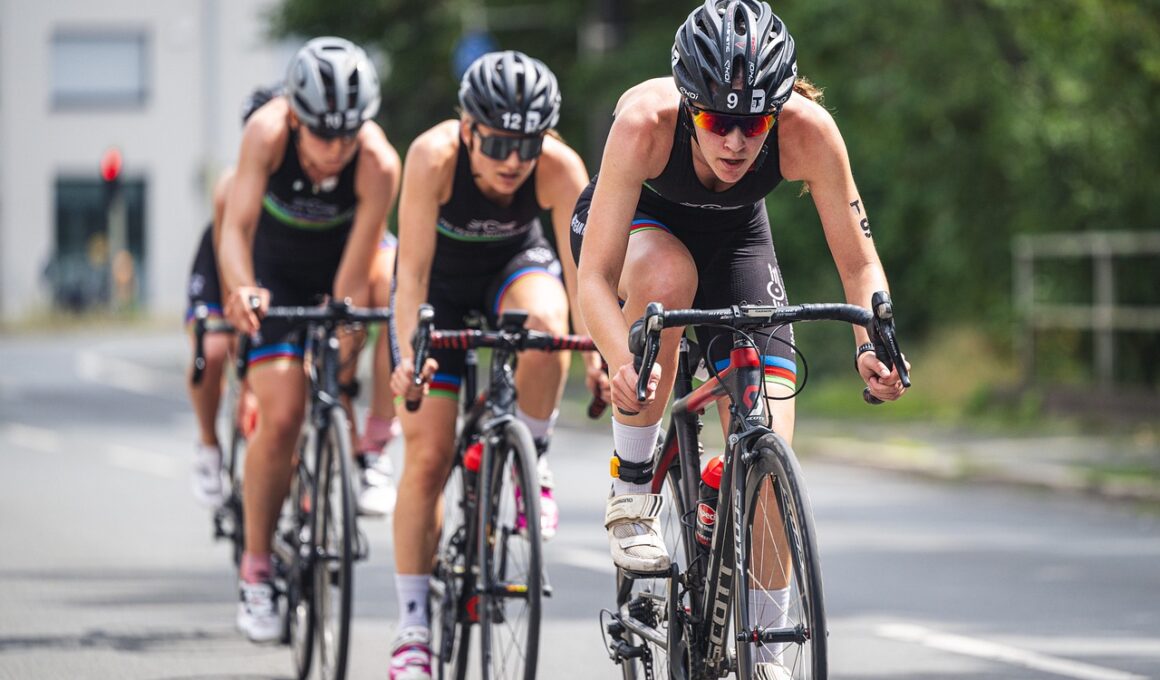Using Interval Training to Overcome Cycling Plateaus
Interval training is an essential technique for cyclists looking to push beyond their current limits. By alternating between high-intensity efforts and recovery periods, this training method enhances both anaerobic and aerobic capacity. Cyclists often experience plateaus in their performance, characterized by stagnation in speed and endurance. To break through, incorporating intervals into training regimens becomes vital. This might include sprints followed by slow tempos or hill intervals. Understanding your current fitness level helps tailor the intervals appropriately. Safety should always be a priority; proper warm-up reduces risks of injury. As you begin, set achievable goals, progressively increasing intensity and duration of efforts. Developing a structured plan will provide direction. Remember, intervals shouldn’t be your sole workout mode. Making them a part of a diversified training plan ensures well-rounded fitness. Periodization techniques can complement interval training by mixing training phases. Following these principles fosters continuous adaptation, making you a stronger cyclist. Consistency over time paves the path to breaking through performance barriers. Regular evaluation of your progress keeps motivation levels high. Seek advice from professionals when needed for personalized approaches. Together, these factors form a powerful combination for success.
Effectiveness lies greatly in the implementation of effective intervals. To ensure optimal results, various protocols exist for cyclists. For instance, the Tabata method is particularly renowned; it consists of 20 seconds of maximum effort followed by 10 seconds of rest, repeated for 4 minutes. Alternatively, the 4×4 method focuses on four minutes of intense cycling at a high heart rate level, followed by four minutes of active recovery. Both methods emphasize short bursts, maximizing the efficiency of workouts. Additionally, longer threshold intervals can further enhance cycling power and endurance. Balancing interval workouts with steady-state rides is critical. This combination builds a solid aerobic base, essential for longer rides. Tracking performance metrics during intervals is equally important. Utilizing devices like heart rate monitors informs optimal intensity levels, while apps map progress over time. Incorporating variability in workout environments, such as hill climbs or wind resistance, challenges the muscles differently. Engaging in group rides offers social support and healthy competition. Participating in structured training groups, either online or in-person, can enhance motivation. Combining all these elements fosters not just improvement in cycling performance but also an overall enjoyable training experience.
Creating a Balanced Training Plan
When developing a balanced training plan around interval workouts, consider both intensity and recovery. Recovery times vary based on the workout’s intensity; they are crucial to ensure muscle repair and growth. Each week, structure your training sessions, including a mix of intervals, steady rides, and rest days. An effective training plan includes periodization, where training load fluctuates, allowing the body to adapt without leading to burnout or stagnation. Consult a training calendar to monitor periods of buildup and taper, particularly before events. Incorporate strength training exercises into your routine. Strong muscles support better power output, improving efficiency on the bike. Focus on legs and core, integrating squats and planks to fortify foundational strength. Nutrition plays a critical role in training effectiveness; consuming adequate protein supports muscle recovery. Additionally, staying hydrated ensures optimal performance during high-intensity efforts. Consider recovery strategies like massage or foam rolling, allowing the muscles to relax. Mixing interval types, such as short sprints or longer efforts, keeps training stimulating. Pay attention to your body responses to identify what works best for you. Personalizing your training based on feedback maximizes continued progress.
Regular assessments aid cyclists in breaking plateaus effectively. Utilize methods like the Functional Threshold Power (FTP) test to gauge improvements accurately. Assessing at predetermined intervals or after training blocks helps pinpoint progress or areas needing adjustment. Understanding your current fitness level equips you to set subsequent goals. Ensure that you evaluate improvements in both speed and endurance; this balance fosters long-term success. Employ varying routes and conditions for assessments, simulating different race environments. Cross-training activities can also provide a break from cycling, enhancing cardiovascular fitness without overworking specific muscles. Remember to incorporate flexibility workouts, as they improve overall performance. As you continue to adapt your training, it’s essential to listen to your body for signals of fatigue or overtraining. Being responsive reduces injury risks and maintains motivation. Don’t forget to celebrate milestones, no matter how small. Providing positive reinforcement keeps momentum moving forward, especially during challenging periods. Engage friends or training partners to create accountability and encouragement. Following these suggestions leads to continual improvement, facilitating breakthroughs to enhance your cycling experience significantly.
Motivation and Mental Resilience
Maintaining motivation is crucial in overcoming cycling plateaus. Interval training, while demanding, should also be enjoyable. Identify your reasons for cycling; whether fitness goals or competition drives you, recognize these motivations during tough training days. Set short-term achievable goals alongside long-term aspirations. Tracking progress visibly in a journal or app becomes beneficial; seeing improvements fosters a sense of accomplishment. Mental resilience develops through consistency. Surrounding yourself with like-minded individuals can support your journey. Engage in cycling communities, whether online or local groups, for inspiration and camaraderie. Attending events or challenges alongside others builds motivation to push through difficult training sessions. Periodically reassess your training approaches and remain flexible to change when necessary. Exploring new cycling routes or joining different riding groups can reignite excitement. Allow for rest days within your training regime; recovery time enhances both enjoyment and performance. Consider employing mindfulness practices, like meditation, to manage stress and enhance mental clarity. Visualization techniques before rides can prepare your mindset positively. By fostering a strong mental foundation, cyclists remain determined to push through any barriers that arise. Remember, cycling is as much a mental discipline as it is physical.
In conclusion, interval training is a proven method for cyclists determined to overcome performance plateaus. Consistently including intervals in training routines cultivates strength, speed, and endurance. Understanding your unique physical capabilities allows for more personalized training strategies, adapting intervals to best suit your needs. Engaging in regular assessments empowers cyclists to recognize improvement, fostering new goals. Additionally, pursuing a balanced workout regimen provides optimal physical and mental health benefits. Ensuring recovery, nutrition, and strength training are integral parts of this journey creates a comprehensive cycling lifestyle. Motivation remains a key player; seeking connections and maintaining excitement nourishes development. Explore different formats of training, allowing internal and external variations to enrich experiences across the board. Ultimately, dedication and adaptability define success in cycling. Harnessing the advantages of interval training alongside a thoughtful approach ensures continuous progress towards cycling aspirations. Long-lasting improvement comes from commitment to this balanced training emphasis. Consider incorporating insights shared here to refine your own cycling journey. Use intervals wisely as tools for growth, emphasizing both enjoyment and effectiveness during this process. The cycling world is vast and filled with opportunities for success: seize them through strategic interval training!
Fear of failure can be a significant hurdle in this sport. Achieving success in cycling is subjective; everyone’s peak is different. Embracing this uniqueness keeps personal progress in perspective, promoting continuous growth regardless of comparisons to others. Learning from setbacks while pushing boundaries empowers cyclists. Ultimately, each interval session is an investment towards unlocking potential. Open communication with coaches or trainers often provides valuable insights and direction. Their support acts as a catalyst for speedier progress. Sharing experiences among peers enriches the process. Training doesn’t occur solely on the bike, as cross-training amplifies results. Incorporate activities like swimming or strength training for diversified fitness gains. Prioritizing mental well-being alongside physical training ensures a holistically achieved cycling discipline. Embrace the journey in cycling, understanding that each small step matters. Cycling brings both challenges and triumphs; acknowledging this duality enriches the experience. Set achievable milestones, continuously reminding oneself of the passion that drives this endeavor. The path to improvement and endurance is a winding road of discovery. This insight fosters respect not just for cycling, but one’s capabilities to overcome obstacles. Celebrate your cycling journey, acknowledging every small victory along the way.
Final Thoughts
Cyclists should continue discovering ways to refine their training. Stay adaptable as recovery, motivation, and new practices evolve. The cycling landscape is always changing; these changes require an open mindset. Adopting a progressive approach allows for sustained growth and development. Innovative training techniques are constantly emerging. By committing to intervals and various training principles mentioned, cyclists can consistently break free from plateaus while transcending personal performance. Maintaining a healthy balance between intensity and recovery ensures proper adaptation. Collaborate with fellow cyclists to share various experiences, exchanging valuable information about training methods. Revisiting personal goals frequently adds fresh perspectives, invigorating the process. Make the cycling journey enjoyable; fostering positive experiences keeps motivation levels high. Consider participating in local events or challenges to keep things exciting. Remember that cycling is a privilege, an opportunity to explore and grow both physically and mentally. Touring beautiful landscapes while testing limits enriches life greatly. Keep pursuing greatness on the bike; employ the intervals method strategically for optimum results. Every ride holds the potential for breakthroughs. Stay focused on the journey, bask in the joys and challenges alike. Embrace each pedal as a step towards the next plateau!


